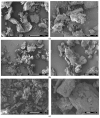Multi-Analytical Approach for the Acid-Base, Thermal and Surface Properties Assessment of Waste Biomasses
- PMID: 39683892
- PMCID: PMC11643424
- DOI: 10.3390/molecules29235735
Multi-Analytical Approach for the Acid-Base, Thermal and Surface Properties Assessment of Waste Biomasses
Abstract
A multi-analytical approach was used to comprehensively characterize the acid-base, thermal, and surface properties of agri-food processing wastes (i.e., original and pre-treated bergamot, grape and olive pomaces). These biomasses, often underutilised and inadequately studied in terms of their physicochemical properties, were investigated under varying ionic strength conditions at t = 25 °C. This investigation uniquely integrates multiple advanced techniques: Brunauer-Emmett-Teller porosimetry, Scanning Electron Microscopy, Thermogravimetric Analysis coupled with Fourier Transform Infrared Spectroscopy, Differential Scanning Calorimetry, Attenuated Total Reflectance Fourier-Transform Infrared, and potentiometry to provide a holistic understanding of these biomasses potential for environmental remediation. The modelling of ionic strength-dependent acid-base behaviour, established using an extended Debye-Hückel-type equation, revealed the dominant role of carboxylic groups as active sites across all pomace types, although with variations in abundances across the different samples. Additionally, morphological analysis highlighted the presence of irregularly shaped particles, heterogeneous size distributions, and distinct thermal stability trends, with grape pomace exhibiting the highest mass loss. These findings underscore the significant potential of these biomasses for the remediation of cationic pollutants from natural waters. Moreover, this comprehensive characterisation not only advances the understanding of agri-food waste valorisation but also provides a robust framework for designing targeted strategies in environmental applications.
Keywords: acid-base properties; agri-food waste; biobased material characterisation; biomass valorisation; biosorbents; circular economy.
Conflict of interest statement
The authors declare no conflicts of interest.
Figures





References
-
- Berenguer C.V., Perestrelo R., Pereira J.A.M., Câmara J.S. Management of Agri-Food Waste Based on Thermochemical Processes towards a Circular Bioeconomy Concept: The Case Study of the Portuguese Industry. Processes. 2023;11:2870. doi: 10.3390/pr11102870. - DOI
-
- Oliveira M., Teixeira B.M.M., Toste R., Borges A.D.S. Transforming Wine By-Products into Energy: Evaluating Grape Pomace and Distillation Stillage for Biomass Pellet Production. Appl. Sci. 2024;14:7313. doi: 10.3390/app14167313. - DOI
-
- Kwikima M., Mateso S., Chebude Y. Potentials of Agricultural wastes as the ultimate alternative adsorbent for Cadmium removal from wastewater. A review. Sci. Afr. 2021;13:e00934. doi: 10.1016/j.sciaf.2021.e00934. - DOI
Grants and funding
LinkOut - more resources
Full Text Sources

